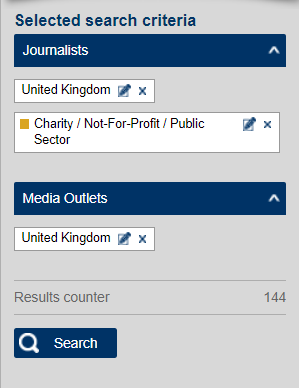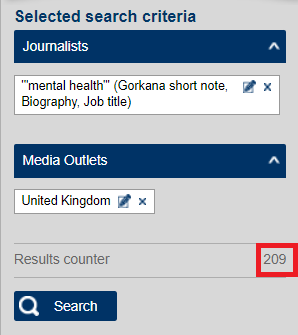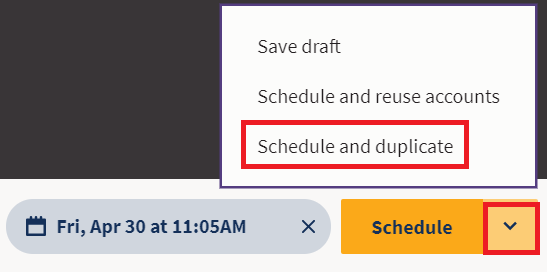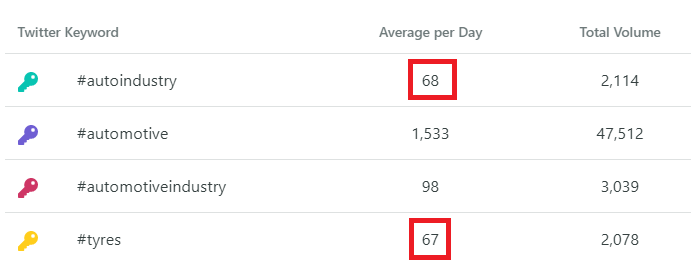
Monday April 26, 2021
Cool things you likely didn’t know you could do with your PR tech stack
10-min read
Whether you work in-house or at an agency, most of us use some of the same tools across the PR industry, from Gorkana’s media database and monitoring coverage with Google Alerts to HootSuite or SproutSocial for social media management. But we don’t always get the most out of them.
Here are some quick tips and tricks that help you get even better outcomes from the same tools, such as creating a better-targeted press list, identifying fresh media opportunities and finding hashtags with better reach.
1. Keyword Search in Gorkana to create a targeted press list quickly
What is Gorkana
Gorkana is one of the oldest and most popular media intelligence tools. While many new rivals have emerged, including Meltwater, Propel PR and Roxhill Media, Gorkana is largely the database of choice for PR professionals looking to contact journalists around the world. Gorkana is a paid service, charging about £5000 annually for its media database.
How you currently use it
Most PR professionals search for journalists on the platform in the following way:
You click on the tab “Media Database” on top. Then select “Database search”. Under search criteria, you select your “Sector” and “Country” of the journalist and media outlet.
For example, if you were doing PR for a nonprofit that works on mental health issues, you would search for journalists in the UK covering the nonprofit sector. It gives us 100+ results.

That’s a lot of results, so we would then sort the list by “Outlet Popularity” to bring up names from top-tier publications first. Now if you are time-poor, you would create a list from the names on the first two pages and send them a press release.
But even if the profile of every journalist on that list mentions the specific sector you’re interested in, your story may not necessarily be relevant to them.
Irrelevant pitches annoy journalists and can sour relationships before they even start, especially if they clog up their inboxes. So next time you have a client that really is relevant to them, you may find that you’ve been blocked for spamming.
Instead of sending your pitch to every journalist on the first two pages of your search, it is worth narrowing down the list by manually going through the Twitter account of each journalist and/or googling their names to see if their recent articles cover exactly the kind of story you are pitching.
After a few hours, you would then have a very specific list of top-tier journalists who are the right fit for the story and maybe the client.
Downsides of searching by sector
If you work at an agency, then this is not the only client you have. So you would need to repeat the same process every time. Given the fast-moving nature of the news cycle, pitches and press releases need to be sent fast and you don’t have the time to create a specific list every time.
Also, this means you tend to look only at top-tier publications to optimise the process and not even consider lesser-known niche publications or blogs that may have a more engaged audience.
Moreover, searching only by sector means you might lose out on the opportunity to pitch to journalists interested in the topic of your story but not necessarily the sector in which it sits.
For example, let’s say you want to pitch an op-ed by the founder of the nonprofit on the recent introduction of a bill related to mental health. If your sectoral search was confined to “nonprofit”, you might not find an editor who covers legal affairs and is passionate about mental health stories.
Enter Keyword Search
Go to “Media Database” > “Database Search” > “Type of Journalist” > “Keyword”. Enter a keyword – usually the niche topic that your story is about. Going with the above example, you would search for “mental health” rather than the sectoral reference, “social issues”. Ensure that if the phrase contains two or more words, you enclose it with double inverted commas. If you don’t, your search results may give you journalists who have mentioned “health” not “mental health” in their profiles.
After entering the keyword, select “Gorkana short note”, “Biography” and “Job title”. This means that the keyword should be present in any of these three areas on their profile.

As a result of this procedure, you will get a much more targeted press list because everyone in the search result has mentioned that they cover or have covered your story’s niche topic in the past.
Similarly, if you want to pitch an op-ed on a story related to race that is running in the news, search for news editors or op-ed editors who have mentioned “race” or “racism” in their profile.
2. Setting Google Alerts on competitors to find opportunities for your company
What is Google Alerts
Google Alerts is one of the best free services out there to track any mention on the internet. It is a free service that allows you to see mentions for specific keywords and filter them via sources of “News”, “Blog” or “Web”.
How you currently use it
Chances are you have already subscribed to Google Alerts for keywords like your company’s or client’s brand name and the name of the CEO. This helps you monitor any coverage received.
Monitoring media coverage is indeed an important part of media relations and this is one of the best ways to do it.
Checking out your competitor’s mentions
Google Alerts can also help with another important element of media coverage: selecting the best outlets.
Normally, you would just keep tabs on what your rivals are doing. So, for example, if you were looking for more interview opportunities for your CEO, you would monitor where your competitors are getting interviewed. Or, keep an eye on where they are guest posting if you were wanting to guest post more often.
But instead of doing all of this manually, just use the tool you have been using for monitoring your client/company’s coverage to track competitors’ mentions. You can set Google Alerts for once a week or not set them at all, as you can just go to alerts.google.com once in a while, when you are looking for ideas, and search for names of competitors in double inverted commas and source as “Blog” or “News” depending on your goals.
For example, a quick Google Alerts search of one of our competitors revealed an interview he had done for a top-tier trade magazine. The interview was from more than a year ago and was part of a series that the magazine runs. Turns out the outlet still runs that interview series where we can potentially be featured in the future and it took us less than five minutes to find out about it!
3. Save time when creating social media posts on HootSuite by using the “Duplicate” button
What is HootSuite
HootSuite is a social media management tool that PR and marketers use to schedule posts and analyse data. It is a paid platform, with plans ranging from £12 to £450 per month or more, depending on your needs, as of 2021.
How you currently use it
If you use HootSuite to post on Twitter, Facebook, LinkedIn or Instagram, you would usually click on the “Create” button, followed by “Post”.
For LinkedIn and Facebook, write the caption, add an image, and ensure the preview looks good. You then click “Post now” or “Schedule for later”. You note the time when you want it to go out and then click “Schedule”. The post is scheduled.

Downsides of using the “Post now”/ “Schedule” option
The downside of this process is that you have to repeat it in order to post the same update on Twitter and Instagram because they have different copy and design requirements: Twitter’s 280-character limit and Instagram’s image specifications.
That might not seem too onerous, but it will become so if you are a regular poster and use a lot of images and videos that are slower to upload.
Enter the “Post and duplicate” or “Schedule and duplicate” option
Hootsuite overcomes the problem of post duplication by allowing you to make a draft of the post, then adjust/tweak so that it can be scheduled for posting on other platforms. This saves valuable time as all you now have to do is simply edit the hashtags, links and images as you need while keeping the rest as is.
Most people don’t use this option because it is not easily visible on the screen. To find it, click on the little drop-down button next to “Post now”. Now click on “Post and duplicate”. Similarly, if you have selected the “Schedule for later” option, click on the drop-down button next to “Schedule” and select “Schedule and duplicate”.

4.Use SproutSocial to find Twitter hashtags that will give you better reach
What is SproutSocial
SproutSocial is also a social media management tool like HootSuite. Its price ranges from $99-249 per month. Depending on the plan, it provides publishing, reporting and competitor analysis.
How you currently use it
If your plan provides an analysis of trends for Twitter keywords, then chances are you use the “Keyword Volume” chart to see when there is a spike in the use of certain keywords. It helps you keep updated so you can investigate if there have been any developments in your industry that you should also post about.
And while that is good, there is one much more interesting section in the Twitter Keyword Report.
Enter “Stats by Keyword”
“Stats by Keyword” gives you the average number of tweets per day, total volume and growth trend of keywords or hashtags that you have chosen.
Now you might know how hashtags are a great way to be found by new users on Instagram. Since you can add up to 30 hashtags on Instagram, a best practice is to use a combination of wide and niche hashtags. And the Instagram platform provides you with the number of posts under each keyword, allowing you to use a combination of some with lots of posts and others with very few.
But Twitter does not provide that information and given its character limit and the nature of the platform, using more than three hashtags on a tweet comes across as spammy. This is where this information from SproutSocial comes into use.
If you have found that your posts with one specific keyword receive a large number of impressions every time as compared to other posts, chances are it is showing up as one of the top tweets for that keyword. The large number of impressions show that not only is it showing up as a top tweet but that people are also looking up that hashtag.
Now, let’s say your company or client is in the automotive industry and you found that your posts with hashtag #tyres get a lot of impressions, but you are also using other hashtags that do not get on top tweets. In order to find if you should use any of the other hashtags enter them as chosen words in SproutSocial.This would look something like this:

You can see from the report why your other words are not ranking. It is because they have a lot more competition. Therefore, you need to find keywords that have similar total volume and similar average number of tweets per day.
So now google some alternative tags to the ones that are not working. For example, google “hashtags #automotive industry”.

This is one of the results that come up. Now place the new hashtag #autoindustry suggested by Google in SproutSocial to check its stats.

You can see how this has very similar stats under average tweets per day and total volume. This means when you use this hashtag, chances are tweets with this hashtag will also most likely start to gain a lot of impressions.
It might take a couple of keywords before you find the one that fits. That’s because some of the keywords you try may have a lot more average tweets per day or a lot less. When it is a lot more, it means there is a great deal of competition and it would be harder for you to rank. When it is a lot less, it means it is an uncommon keyword and not enough people are searching for that hashtag. So it wouldn’t help you to use that.
You ideally want one that has similar stats to the one that is already working for you. Once you find that, use it in the coming weeks and monitor its performance. Like everything else in digital marketing, the results will tell you whether this tip is useful for you.
Conclusion
Sometimes you don’t need yet another tool, just a fresh way of using an old one to get better results. Do you have any such tips and tricks? Tweet to us and let us know.
Curzon PR is a London-based PR firm working with clients globally. If you have any questions, please feel free to contact our Business Development Team bd@curzonpr.com







Follow us